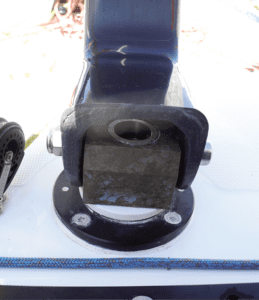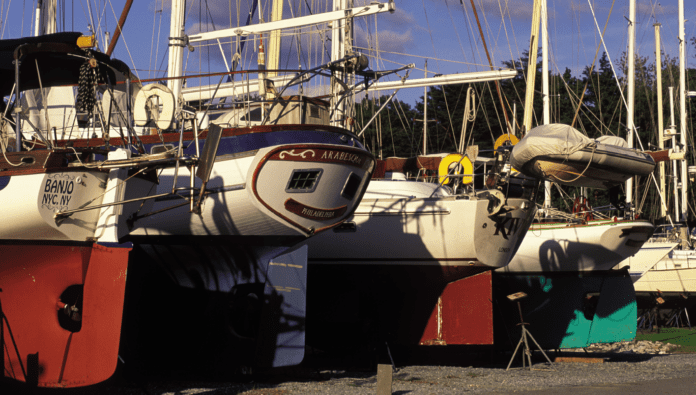Cruising Club of America member Mike Keyworth, has done some significant research into emergency steering. Mike has had decades worth of ocean racing and cruising experience coupled with running one of New England’s premier boatyards. His own vintage Swan 44 was his research platform and the approach he developed for emergency steering is worth serious consideration. The cornerstone of Keyworth’s jury rig is a scaled down Galerider drogue that he uses to implement directional control. In this case, the venerable Galerider delivers drag to a point near one side of the center of lateral force (CLF) or the other. The technique works best when reaching or close-hauled. But can be used downwind with just a jib and careful attention to trimming the bridle lines.
Part of the innovation in Keyworth’s system is how he rigged the two legs of the bridle. Normally, when a larger drogue is rigged in heavy weather, the lines lead to the stern quarters and the goal is to slow the vessel and inhibit yaw. But by moving the bridles forward, closer to the vertical axis of the CLF, the stern of the vessel is free to swing to the port or starboard resulting in the boat turning in the opposite direction. Keyworth has found that one bridle can be made fast, and by easing or winching in on the other bridle, a single winch can be used to affect both turns to port or starboard.

Drogue steering doesn’t work the same way on every boat. It may take some experimenting by moving bridle lead blocks a bit forward or aft of the CLF. This is easy to do aboard boats with alloy toe rails that allow blocks to be attached randomly. In other cases, some temporary attachment points may include the use of spring line cleats.
By temporarily moving bridle blocks fore and aft you can determine what point delivers the best steering response. Start out experimenting in 10-12 knot conditions and after mastering the art of holding a relatively steady course on a beam reach, head up and see what it takes to sail close hauled. Once you have mastered tacking and jibing, get a feel for deep reaches and a run.

Running with a jury rig steering system will likely require dousing the main and settling for a jib only sail plan. Rolling along in a seaway requires a lot more attention, care needs to be taken not to have a slackened bridle sink under the boat. To help prevent this, use polyester/Dacron braid floating lines for the bridle which lessens the risk of a line getting caught in the prop or hung up on a rudder or its remnants. A bungie cord on either side could also be used to help take up slack.
After several years of sea trials, Mike has pinned down some valuable modifications to his approach to drogue steering. His research included the removal of his Mk1 Swan 44’s rudder to make testing even more realistic. Among the most important findings was a decision to add chain and two swivels to the drogue, to keep it immersed in a windy, rough sea. This hardware modification also kept the drogue from spinning, which can create hockles in the tow line. He tested 12- and 18-inch diameter drogues that proved to be too small. A 36-inch model steered well but he lost 1.5 knots. The 30-inch drogue turned out just right, causing the loss of only about one knot. Keyworth noted that the steering drogue concept works quite well when motor-sailing or powering with no sails set.

place on a boat designed for both wheel and rudder steering. Emergency steering
is often an afterthought on contemporary
boats (see “The Hunt is on for a Quality, Well-placed Emergency Tiller,”
PS November 2008).
AN AUXILIARY RUDDER
The ultimate in rudder replacement involves the installation of a three-part auxiliary rudder. Part one involves mounting a stern bracket assembly to hardware already attached to the transom. This bracket incorporates a gudgeon and pintle axis built into a cassette like structure that supports an emergency rudder blade and a detachable tiller. In essence this gives a crew a chance to install a transom hung rudder while at sea in conditions that are anything but tranquil.
The design parameters are challenging, and some transoms make the job easier than others. Start with a look at your existing rudder. Using lines, plans, or a tape measure determine the rudder draft with zero heel and approximate surface area of the rudder. Next look at the transom and measure the rake (angle from the vertical). Next locate where the cassette bracket support hardware will attach to the hull. Think of the emergency rudder blade as a powerful crowbar as well as steering appendage. Many vessels need sizable backing plates on the inner side of the transom to handle the loads. The longer the rudder blade, the more the load on the cassette, rudder hardware, and the transom structure itself.
Offshore racing rules stipulating a fully functional rudder that can be fitted at sea has prompted most manufacturers of windvane self-steering systems to also offer emergency rudder options. And our own testing with various drogues yielded some interesting observations regarding rigging a drag device for steering (see “Sailing Without a Rudder,” Practical Sailor June 2017)









































Drogue steering is a contingency every sailor should know (read “Sailing Without a Rudder,” June 2017). Even if you have an emergency rudder, a drogue can be rigged in a few minutes and will stabilize the boat and stop the rolling while the jury rudder is installed. While a commercial drogue set up is ideal, an anchor hanging below fenders works surprisingly well. Rig it to a bridle adjusted using winches through snatch blocks at the mid-ships cleats (not the transom in most cases). Most important is to practice with the rig.
Egret sailed 1500 miles across the Atlantic with a rig like this. Far from ideal, but very practical. Every cruising boat carries everything that is needed.
I am surprised more effort is not being used to experiment with using kites on cruising sailboats. They could potentially be used with some advantages in lieu of a spinnaker for downwind cruising, with an adjustable bridle the pulling angle could be adjusted for steering without a rudder, if included with the life raft abandon boat supplies they could be employed to move the life raft along and should also be highly visible for emergency responders.